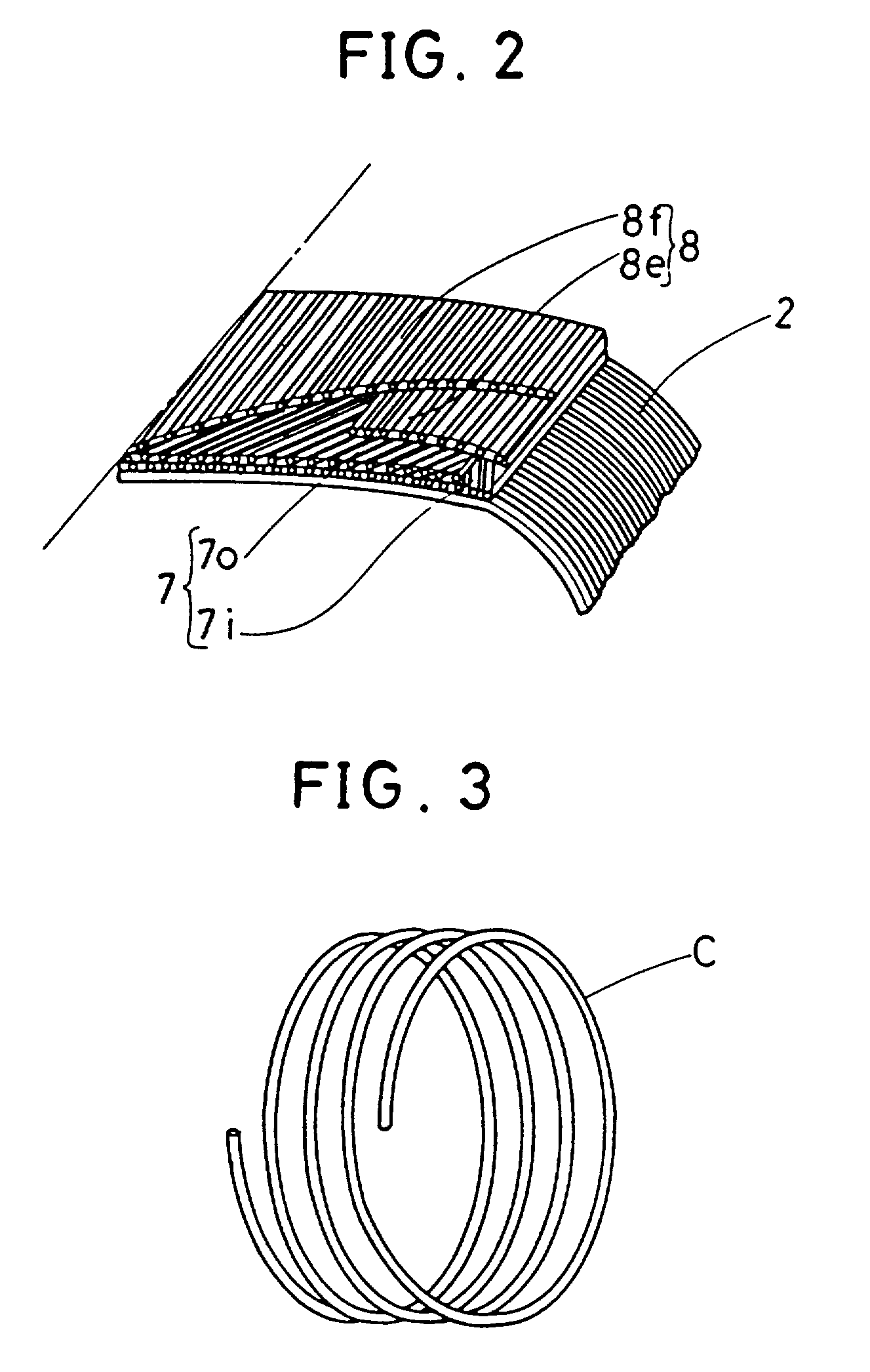Pneumatic radial tire and method for manufacturing same
a technology of pneumatic radial tires and radial tires, which is applied in the direction of tires, vehicle components, domestic applications, etc., can solve the problems of inability to withstand general use, temperature at the tread portion rapidly rises, and the adhesion between the metallic cord surface and the rubber in the belt is broken, so as to prevent the hooping effect of the band at the shoulder portions of the bel
- Summary
- Abstract
- Description
- Claims
- Application Information
AI Technical Summary
Benefits of technology
Problems solved by technology
Method used
Image
Examples
example 2 com
255 / 40 VR17 255 / 40 VR17 255 / 40 VR17 Belt material metal cord metal cord metal cord Number of belts 2 2 2 Angle of belt 24 degrees 24 degrees 24 degrees Carcass material polyester polyester polyester Structure of band full band full band full band 1 ply 1 ply 1 ply joint: none joint: none joint: present Band material nylon 66 nylon 66 nylon 66 1260d / 2 1260d / 2 1260d / 2 Cord diameter (d) 0.60 mm 0.60 mm 0.60 mm Rubber 0.15 mm 0.15 mm --thickness (t) Pitch (p) 0.90 mm 0.90 mm 0.90 mm Tension of cord in winding (T) Crown part 35 g 35 g --Shoulder part 45 g 45 g --Distribution of shoulder part shoulder part shoulder part elongation crown part > crown part under given shown in shown in shown in load of band cord Breaking speed 350 km / h 300 km / h 260 km / h
example 1
[0121] Example 1 has a distribution of elongation at given load of the cord of the full band layer as shown in FIG. 17.
[0122] Example 2 is similar to Example 1 in apparent structure, but the distribution of elongation at given load of the cord of the full band layer is reverse to the profile of Example 1 as shown in FIG. 18.
[0123] Comparative Example 1 wherein on the belt was provided a conventional full band layer possessing a joint extending in the widthwise direction at one position in the circumferential direction of the tire, has a distribution of elongation at given load of the cord of the full band layer as shown in FIG. 19.
[0124] As a result of indoor durability test of these tires in the same conditions as mentioned above, Example 1 of this invention presented a marked improvement effect as compared with Comparative Example, and its durability performance was nearly equal to that of the structure with an intervening edge band layer mentioned above.
[0125] Also, in the case o...
first embodiment
[0153] the diameter expanding means is the one particularly called as segment method by the present applicant, and as shown in FIGS. 23 to 25, a plurality of segments 41, for example, 8 to 32 segments, having the predetermined width and length are arranged over the entire circumference radially inside of the forming annular body.
[0154] The segments 41 are made of a hard material, such as aluminum and iron. The sectional shape of each segment in the axial direction of the drum is the same as or similar to the sectional shape (final finished shape) of the band of the finished tire in the mold, and more practically a convex shape of which absolute value of the difference between the middle portion stretch of the band and the shoulder portion stretch is 0% to 2%. The length SL of each segment is determined by the number of segments, and the width SW is determined by the belt width.
[0155] Each segment is mounted on the rod of cylinder 42, and each cylinder is fixed to the base frame 12, ...
PUM
 Login to View More
Login to View More Abstract
Description
Claims
Application Information
 Login to View More
Login to View More - R&D
- Intellectual Property
- Life Sciences
- Materials
- Tech Scout
- Unparalleled Data Quality
- Higher Quality Content
- 60% Fewer Hallucinations
Browse by: Latest US Patents, China's latest patents, Technical Efficacy Thesaurus, Application Domain, Technology Topic, Popular Technical Reports.
© 2025 PatSnap. All rights reserved.Legal|Privacy policy|Modern Slavery Act Transparency Statement|Sitemap|About US| Contact US: help@patsnap.com



